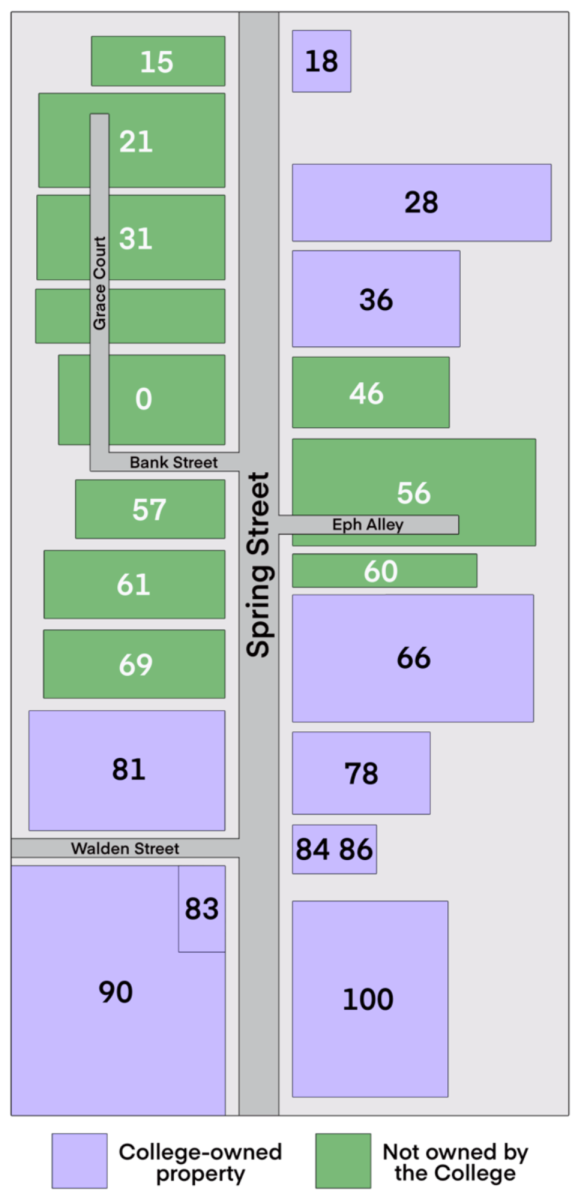
Many students receiving financial aid at the College are accustomed to seeing $925 hit their bank accounts from “Williams College Direct Pay” at the start of each semester. But this money — known as the Personal Expenses Grant (PEG) — has only existed in its current form since 2022, when the College established its all-grant financial aid program. As Student Financial Services (SFS) determines the amount of the PEG for the 2025-2026 academic year, the Record asked students about their reflections on the grant. Some expressed celebrations of its arrival with extra meals on Spring Street, while others felt frustrated by the grant’s insufficiency.
Establishing the PEG
Before the introduction of all-grant aid, students received an “allowance” as a part of their participation in the College’s former work-study requirement, according to Director of Student Financial Services Ashley Bianchi. Some students received different amounts of allowance money, depending on whether they had outside loans or scholarships, but most received a uniform amount of $2,700 per year through direct deposit. The allowance, allotted from students’ work-study earnings, was intended to cover both travel and personal expenses. Today, the College’s all-grant financial aid plans cover travel expenses separately, and students receive the PEG with no work-study requirement.
Students are given the option to divert their PEG money towards their parent contribution, but otherwise, the money is intended to go to students directly, Bianchi said. “It was really important to us to make sure that [the grant] was directly deposited to students’ bank accounts, rather than to reduce their parent contribution,” she said. “It is meant to cover the kinds of expenses that your work-study earnings would have covered in the past — things like co-pays, haircuts, your cell phone bill, eyeglasses … and then the occasional going-out-to-eat meal.”
Students tend to interact with SFS individually, rather than as a group, and as a result, many told the Record that they didn’t know whether the amount of PEG money is the same for other students. For instance, some told the Record that they believed that the amount given differs by class year — which is false.
The work-study predecessor of the PEG did not vary according to international versus domestic status. By contrast — while financial aid level and class year don’t factor into the amount of money students receive — the PEG in its current form differentiates between domestic and international students, giving domestic students a grant of $1,850 per year and international students $2,700.
International students receive more PEG money, Bianchi said, because their financial aid plans only account for one trip home per year, whereas domestic students’ financial aid pays for two trips home. “The expectation is that international students will have some extra expenses during vacation times where domestic students would likely get an extra trip home,” Bianchi explained.
SFS chooses to give domestic and international students on financial aid the same amount of PEG money regardless of demonstrated financial need, because they expect all students to have similar campus expenses throughout the semester. “You could argue that higher-needs students have more demands on that Personal Expenses Grant, and I can imagine that could be true, but they also don’t have a parent contribution,” Bianchi said.
Approximately every five years, SFS determines whether a change in the PEG amount is in order, evaluated first through student spending data collected by the College Board and the Consortium on Financing Higher Education (COFHE), an organization of private liberal arts institutions committed to meeting students’ full demonstrated financial need, Bianchi said. She explained that this data — which is gathered from Williams as well as peer institutions such as Smith, Amherst, and Yale — forms the benchmark of the evaluation process, but that SFS works to refine this data by specifically considering the College’s ZIP code and local pricing in the evaluation process. SFS then works directly with students through multiple rounds of surveys and feedback to ensure that the determined amount is sufficient and accurate for students’ expenses, Bianchi said.
“It definitely makes a difference”: PEG recipients express gratitude
For some students, the PEG has caused relief and celebration. “Especially as an international student, you don’t get a lot of scholarships, actually,” said Wendyam Ilboudo ’25, a community college transfer student from Burkina Faso. “There are not a lot of options. You can’t do FAFSA, for example, because it’s federal … so to have this as part of financial aid — it’s not even an external scholarship that you have to apply for. That was huge for me.”
Coco Rhum ’24, who first received the PEG when the program was implemented during her junior year, expressed appreciation for the grant’s introduction. “It was just a great piece of news to receive,” she said. “Obviously, the College would give some money to students before, but not with the same generosity or standardization… I was thrilled, and it definitely makes a difference.”
For Rhum, the PEG offers a sense of financial empowerment. She said she noticed that it reduces the stress students feel about everyday expenses, and allows them to participate in non-essential activities that other students may take for granted. “If friends want to go to Spice Root on a Friday night, especially at the beginning of the semester, once I’ve just gotten the Personal Expenses Grant, I know it’s there,” Rhum said. “I think it just makes me feel a little bit more empowered to make my financial decisions or to make the choice to spend money.”
“I don’t think I would be comfortable without a job”: Ongoing challenges
However, for some students, the PEG doesn’t come close to covering their costs across the semester or replacing their need to work a job on campus. “I use mine to pay for bills, not subscriptions or toothpaste or toiletries, like they say it’s used for,” Teanna Bucci ’26, co-founder of the Low-Income Students Association, told the Record. She said that most of her PEG money goes towards medical payments, such as co-pays on prescription drugs that the school’s insurance doesn’t cover. “My personal grant runs out in about two months, and the rest of the semester, I’m scrounging for change to pay for the things I actually need, including my bills,” she said.
As a result, Bucci said that she thinks that the PEG should take into account students’ level of financial need with a minimum level of personal expense financing for all students on financial aid.
Bianchi emphasized that the College provides a one-time grant to first-years whose total parental contribution is $4,000 or less annually. The First Yard Fund started as a $300 grant in 2022 for items needed for the start of college, including a winter coat, boots, and school supplies, and was later increased to $500. Other than this one-time grant, the College does not calculate the PEG according to student need. “We don’t see an argument as of today that the amount of the Personal Expenses Grants should vary based on level of need,” Bianchi said.
David Cañez ’27 said that his expenses during his first semester at the College exceeded the PEG and First Yard Fund. Cañez has used his PEG for the typical necessities that the College describes as its intended use: toiletries, winter clothes, school supplies, and medical costs not covered by insurance, he wrote in an email to the Record. “I’ve had to overuse my allotted PEG and First Yard Fund through my first semester because my glasses and backpack broke, my meds for the winter weren’t fully covered by the College’s health plan, and I didn’t fully know which snow clothes I’d need beyond a coat and boots,” he wrote. “If I hadn’t had savings from my job before arriving, I’d have been deep in the red.”
“So far, the PEG has allowed me to expand what I initially thought would be affordable for me to spend this semester,” Cañez added.
He still chooses to work as an Admissions Ambassador for the Office of Admission, where he connects with prospective students and offers an authentic look at the experience at the College, to pay for expenses that extend beyond what his financial aid covers. “I would say that working on campus is still essential to surviving as a low-income student,” he wrote. “There are some parts of life that aren’t always covered by First Yard and PEG that end up just falling out of the sky.”
Rhum, like many PEG recipients, has always worked a campus job while at the College. “I think the grant amount would have to be increased by a lot to make me feel okay about not having a campus job,” she said. “But I also think working is important, and I believe that it’s an important part of my education as well.”
Ilboudo, who works at Driscoll Dining Hall to make ends meet, echoed some of Rhum’s sentiments. “I don’t think I would be comfortable without a job,” she said. “I think I’d get to a point where I’m stressed and constantly thinking about, ‘Am I going to have enough money to make it through the end of the semester?’”
Ilboudo described her experience with move-in expenses, travel costs, and emergencies not covered by Critical Need Funding, a resource designated for students facing unexpected financial challenges. “The Personal Expenses Grant works when everything goes well,” she said. “When you have problems along the way, it doesn’t.”








